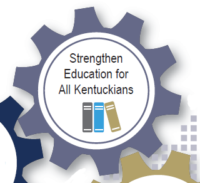 Strengthening education for all Kentuckians is one of the five key strategies in “An Economic Agenda for a Thriving Commonwealth.” Because when we adequately invest in education, we make progress on all of our goals for the commonwealth. A good education can increase individuals’ and families’ economic security and health, strengthen our workforce and plant seeds for ideas and businesses that move our state forward. By investing more in high-quality educational opportunities — from early care through higher education — we can unleash our potential for prosperity and achieve the thriving communities we all desire.
Strengthening education for all Kentuckians is one of the five key strategies in “An Economic Agenda for a Thriving Commonwealth.” Because when we adequately invest in education, we make progress on all of our goals for the commonwealth. A good education can increase individuals’ and families’ economic security and health, strengthen our workforce and plant seeds for ideas and businesses that move our state forward. By investing more in high-quality educational opportunities — from early care through higher education — we can unleash our potential for prosperity and achieve the thriving communities we all desire.
Unfortunately, inadequate state funding for education holds back our kids’ academic success and stifles our economic potential while increasing financial pressure on local sources of funding, which worsens inequalities between poor and wealthy school districts. In fact, the state needs to put about 26 percent more into primary and secondary education than we are today to follow best practices and achieve our goals, according to an important 2014 report. Furthermore, tuition increases at state universities and community colleges, along with inadequate financial aid, burdens young people with skyrocketing student debt, if not pricing them out of higher education altogether. In addition to forcing tuition increases, state budget cuts to higher education have led to reduced student supports for degree completion, making it less likely that struggling students will be successful. The following policy ideas will help Kentucky overcome these barriers and move our people and our economy forward.
Help More Kentucky Families Afford Quality Child Care
Half of Kentuckians live in a child care desert — an area either without a child care center or where there are at least three times more children than child care capacity. The state should raise the income limit to qualify for child care assistance from 160 percent of the federal poverty level to 200 percent, substantially increase provider reimbursement rates and eliminate the family co-pay for those below the poverty line. These measures will allow more Kentucky families to afford quality care and will protect the viability of child care facilities.
Expand Preschool and Kindergarten for All Kentucky Kids
Research shows that full-day preschool and kindergarten have important advantages over partial day programs. However, Kentucky provides only enough state funding for partial day y preschool for disabled 3- and 4-year-olds and all 4-year-olds up to 160 percent of the federal poverty line; and only for half-day kindergarten for all Kentucky kids. Further, the state provides no transportation funding for preschool. To ensure our children have a strong foundation, the state should fund full-day preschool for all 4-year-olds up to 200 percent of the federal poverty line, universal full-day kindergarten and transportation for preschool. Some of the preschool funding should be used in partnership with local child care centers to coordinate full-day care between private providers and public school districts.
Reinvest in Kentucky Classrooms
Per-student funding for Support Education Excellence in Kentucky (SEEK) — our core K-12 school funding formula — has been declining in inflation-adjusted terms since the Great Recession and is inadequate to meet our education goals and ensure equitable opportunities across our commonwealth. For example, state funding for transportation was just 63 percent of the need in 2018, rather than the 100 percent the statute requires — with local districts left footing the remainder of the bill. Though just a down payment on what is needed, an additional $400 million a year in state SEEK funding would begin to restore transportation funding, allow for smaller class sizes and pay for additional necessary staff to support kids who need extra help.
Restore Supports for Student Success
Extended school services (ESS) like tutoring and after-school programs promote students’ success; instructional materials like textbooks facilitate learning; and teacher professional development (PD) ensures educators have the training it takes to teach and lead effectively. These funding streams, which are outside of core SEEK funding, are inadequate, with instructional materials and PD receiving no funding in the most recent state budget. This lack of funding especially impacts students from low-income families as well as less-wealthy school districts that struggle to make up the difference when state funding is cut. An additional $70 million in state funding for ESS would move us toward adequacy, and $38 million is needed to begin reinvesting in instructional materials, PD and Family Resource and Youth Services Centers (which work to minimize the impacts of hunger and poverty on student learning).
Provide Two Years of Tuition-Free College
To put a higher education within reach for all Kentuckians, the state should provide the equivalent of two years of free community college to students attending public higher education institutions. This program would pay full community college tuition and fees — or the same dollar amount toward the first two years at a Kentucky public university — for Kentucky students who do not already have a degree. Covering four semesters for full-time students and eight for students attending half-time would support completion for traditional and non-traditional students alike. Providing tuition and fees would enable students to use other forms of need-based financial aid (such as Pell Grants) and scholarships to cover many of the additional college costs necessary to completion such as housing, food and transportation. As part of the program, the state’s need-based scholarship College Access Program (CAP) should be fully funded so that all eligible students receive it. Currently, inadequate state funding means many eligible students do not receive CAP. Additional investments in higher ed institutions, particularly the state’s community colleges, would help provide adequate student support services to assist degree completion.


